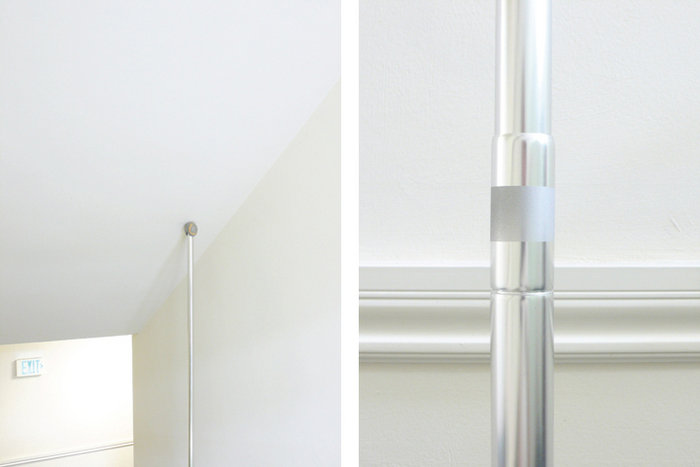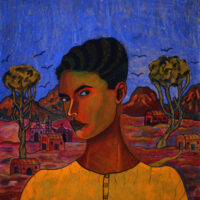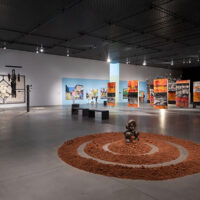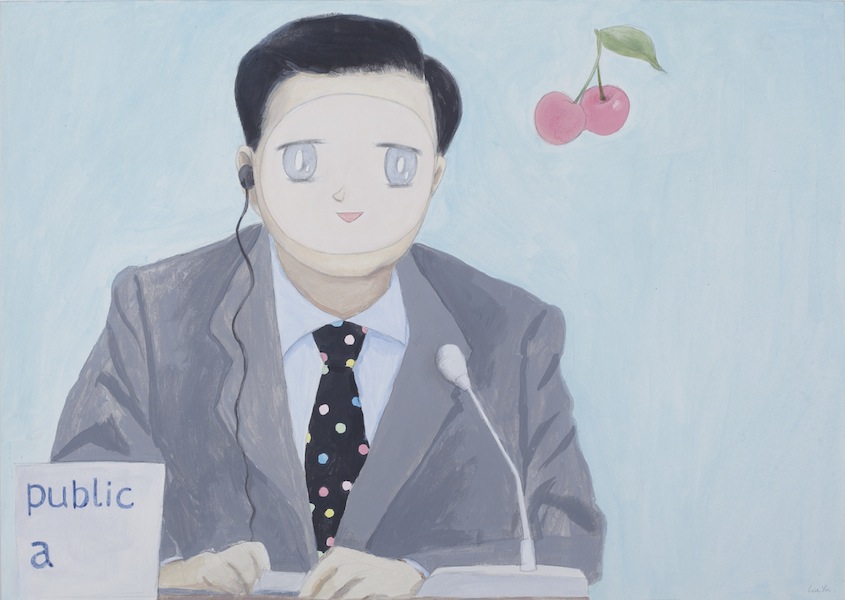
© » KADIST
Yang Guangnan
Itch explores the relationship between technology and daily human experience with a motorized arm that extends from within the gallery’s wall, moving up and down while holding a projector that shows a desperately scratching pair of hands.

© » KADIST
Zai Kuning
Justice (2014) presents viewers with a curious assemblage: a wooden gallows with slightly curved spindles protruding from the topmost plank, which in turn is covered with rudimentary netting, the threads slackly dangling like a loose spider’s web or an rib cage that’s been cracked open. A bundle of small red rattan balls hang from the front end of the plank, precariously knotted to a single thread hanging from the gallows’ edge. A book hangs from similar red threads at the plank’s rear, its surfaced wrapped multiple times over with the thread to hold it in place, the red thread resembling blood vessels or connective tissue.

© » KADIST
Yang Guangnan
In Action no. 1 Yang Guangnan reflects on the interiority and exteriority of human-technological experience with mechanical gestures that are semi-human and semi-machine. A hanged shirt mounted upon the artist’s machine rhythmically bounces and rotates in a way that suggests a skeletal interior.

© » KADIST
Ellen Lesperance
Somewhere Along the Black Sea in the Distant North-East, or in Libya in the Furthest South, The Amazons – The Woman and the Girls Children – Exist Just Outside of the Range of Normal Human Experience

© » KADIST
Zai Kuning
Drawing & Print (Drawing & Print)
Converting is a piece about the Orang Laut, often called Sea Nomads, that inhabited the Riau archipelago. They were Christians and pagans that were often oppressed by the majority Muslims in the Riau community and were eventually forced to convert to Islam. Zai conveyed this history in Converting through the stark contrasts of red, white, black.

© » KADIST
Zai Kuning
Drawing & Print (Drawing & Print)
Concerned with the early history of Singapore, Zai Kuning spent many years living with and researching the history of the Riau peoples who were the first inhabitants of Singapore. Inspired by the women of Riau, Back to Mother seemingly traces the central role of maternal figures in nourishing of Riau’s history as an early archipelago kingdom that was Hindu, Buddhist, and animist prior to 14th-century Muslim invasion. Organic materials such as beeswax form a layer of balm protecting threads of red paint symbolic bloodlines in a turtle-formed mandala—a primordial womb that recalls the Hindu and animistic origin of Singaporean society.

© » KADIST
Scott Reeder
Reeder’s works often start with language—and his Pasta Paintings are no different. After the phrase for the title came through his head, the artist set about trying to figure out how to make a mark with pasta. These paintings are the result, made using the pasta as something of a stencil, with the paint being applied after the noodles have been scattered on the painting’s blank surface.

© » KADIST
Pia Camil
Camil has made numerous paintings and photographs of halted projects along Mexico’s highways (she calls them “highway follies”), and of abandoned billboards that look like theater curtains dramatizing failed capitalist strategies. (Espectacular, the colloquial Spanish term for “billboard,” also translates more literally as “spectacle,” and of course recalls Guy Debord’s famous 1967 book The Society of the Spectacle .) In Mexico, the urban landscape has been taken over by billboards; they are totally integrated into the landscape.

© » KADIST
Ben Shaffer
Ben Shaffer’s Ben Deroy (2007) is part performance, part self-portrait, and part spiritual vision. Often the artist works with the motifs of the counterculture and contemporary non-religious spiritualism. The figure hangs suspended—seemingly ascending—animation.

© » KADIST
Li Ming
In the eight-channel video installation Movement , Li Ming uses his body as a prop to interact with different means of transportation. Each channel features footage of the artist moving forward, jumping between various modes of transportation that weave in and out of the frame in a carefully orchestrated choreography. As the artist descends from the loader bucket of a moving construction tractor, he jumps onto a skateboard which he then discards as he lays on top of a suitcase that continues rolling forward.

© » KADIST
Christine Sun Kim
Hand Palm Echo 1 is a digital animation based on Christine Sun Kim’s staircase mural at The Drawing Center in New York (10 March – 22 May, 2022). Sun produced this NFT from a still image of the animation that features a drawn notation of the sign “echo” in American Sign Language. Visually the black and white image depicts two side by side mounds, one labelled ‘Hand’ and the other labelled ‘Palm’.

© » KADIST
Kori Newkirk
LAB (2013) conjures the body as the trace of a sooty hand appears, spectrally, on a crumpled paper towel. His photograph of this throwaway object calls back the body, and the handprint is in fact his own right hand; thus the piece can function as a self-portrait of the artist, in an ironic twist on the art historical genre.

© » KADIST
Natasha Wheat
Drawing & Print (Drawing & Print)
Natasha Wheat’s Kerosene Triptych (2011) is composed of three images, one each from the digital files of the Library of Congress, the Smithsonian Institution, and the Field Museum tropical research archive. The original photographs were taken by anonymous photographers, not as art but as documents of the building of the Panama Canal. The laborers in the images are holding cans of kerosene and spraying it into the foliage.

© » KADIST
Alexandre da Cunha
His Deck Painting I recalls the simplistic stripes of conceptual artist Daniel Buren, or the minimal lines of twentieth century abstract painting, but is in reality a readymade, fashioned from repurposed fabric of deck chairs. Alexandre da Cunha reinvents found objects in surprising ways that combine the material characteristics of Arte Povera with the concerns and techniques of painting. Da Cunha’s work often features flags—either as a found material per se or as a constructed form—that reflect the artist’s interest in issues of nationality, governmental politics, allegiance, and culture.

© » KADIST
Chadwick Rantanen
Telescopic Pole is an adjustable telescopic pole that extends vertically from floor to ceiling and is held up by its own internal pressure. The ends, protected by two, cut-open tennis balls, recall the legs of a walker. For Rantanen’s second solo exhibition at Jancar Jones Gallery, San Francisco in 2010, one pole was placed inside the gallery while the other was located outside.

© » KADIST
Federico Herrero
Federico Herrero’s energetic paintings reflect his experiences on the streets of his native San José, Costa Rica, and in the surrounding tropical landscape. Rooted in Central American folklore, politics, and culture, his works often move beyond the canvas onto the wall or into the streets. In Á rbol y Pelicao (Tree and Pelican, 2009), a tree with cartoonlike creatures drawn in pen beside it emerges from a field of bright swaths of color.

© » KADIST
Alexandre da Cunha
Glaze (Savana) (2005) is an assemblage of found materials: a car wheel, a tire, and a wooden plinth of the type traditionally used to display sculpture. It directly engages with the readymade, a subject that Alexandre de Cunha takes up throughout his practice, often inflecting it with a tropical, and South American–inspired materiality and painterly style that could potentially come across as a stereotype. Here, da Cunha transforms the component parts into a composition that highlights often-overlooked materials of artistic production and cultural mass-production.

© » KADIST
Alexandre da Cunha
In Laissez-Faire (Rainbow Flag) da Cunha has turned a beach towel into both a painting and a flag. Where the printed surface of the towel originally served to enliven this commodity, here the pattern—now stretched and re-presented—suddenly refers to abstract painting’s promises of transcendence. And its crisply painted shape pulls the printed colors into the rectangularity of the canvas and, as da Cunha notes, the graphic iconicity of flags.

© » KADIST
Natasha Wheat
Wheat’s work is built on a strong conceptual framework that weaves together commentary on social and political issues and the radical potential for change. Be Oblivion, in Disconnect (2011) is a sculpture and an intervention. Two cardboard boxes house white neon letters that collectively have the potential to spell “Be Oblivion.” The dismembered phrase is rendered powerless in its present state; the potential power lies with the viewer, who could conceivably reconstruct it.

© » KADIST
Alexandre da Cunha
The series West (Flag 1), West (Flag 3), and West (Flag 6) continues da Cunha’s ongoing exploration of the form’s various vertical, horizontal, and diagonal stripes. Here, da Cunha overlays thick bars of color (blue, green, and red) on photographs of the ocean at sunset with surfers in floating on the horizon. The solid colors contrast with the fading colors reflected in the sunset, and the tilted orientation suggests a familiar California beach scene.

© » KADIST
Bernardo Ortiz
Drawing & Print (Drawing & Print)
Casa de la cabeza (2011) is a drawing of the words of the title, which translate literally into English as “house of the head.” Ortiz uses this humorous phrase to engage the idea of living in your head.

© » KADIST
Mark Bradford
Drawing & Print (Drawing & Print)
This untitled work from 2012 is a print originally made as part of the Wattis Institute for Contemporary Art’s artist limited edition series. It’s contrasting dark and vibrant tones presage his later series of works, exhibited at L. A.’s Hammer Museum as Scorched Earth. These larger works share a map-like quality, looking like aerial views of some scarred urban landscape.
Alexandre da Cunha
- location: London, United Kingdom
- year born: 1969
- gender: male
- nationality: Brazilian
- home town: Rio de Janeiro, Brazil
Zai Kuning
- year born: 1964
- gender: male
- nationality: Singaporean
- home town: Singapore
Christine Sun Kim
- location: New York, New York
- year born: 1980
- gender: female
- nationality: American
- home town: Orange County, California
Yang Guangnan
- location: New York City, United States
- year born: 1986
- home town: Inner Mongolia, China
Mark Bradford
- location: Los Angeles, California
- year born: 1961
- gender: male
- nationality: American
- home town: Los Angeles, California
Pia Camil
- year born: 1980
- gender: female
- nationality: Mexican
- home town: Mexico City, Mexico
Ellen Lesperance
Ellen Lesperance begins with archival footage of various activist events throughout history...
Sarah Conaway
- location: Los Angeles, California
- year born: 1972
- gender: female
- nationality: American
- home town: York, Pennsylvania
Bernardo Ortiz
- location: Bogota, Colombia
- year born: 1972
- gender: male
- nationality: Colombian
- home town: Bogota, Colombia
Scott Reeder
- location: Chicago, Illinois; Raleigh, NC
- year born: 1970
- gender: male
- nationality: American
- home town: Milwaukee, Wisconsin
Ben Shaffer
- year born: 1924
- gender: female
- nationality: Canadian
- home town: Louiseville, Canada
Chadwick Rantanen
- location: Los Angeles, California
- year born: 1981
- gender: male
- nationality: American
- home town: Wausau, Wisconsin
Li Ming
- location: Beijing, China
- year born: 1979
- gender: male
- nationality: Chinese
- home town: Sichuan Province, China
Federico Herrero
- location: San Jose, Costa Rica
- year born: 1978
- gender: male
- nationality: Costa Rican
- home town: San Jose, Costa Rica

© » ARTEFUSE
this quarter (02/07/2024)
The best exhibitions and openings of 2024: North America - ArteFuse It’s an exciting year for art lovers — from Alicia Keys and Swizz Beatz’s world-class collection of contemporary art to the world’s first exhibition exploring Matisse and the sea — there’s something for everyone Abraham Ángel: Between Wonder and Seduction Dallas Museum of Art Through 28 January 2024 Praised as one of the leading artists of his generation, Abraham Ángel produced just 24 paintings — four of which remain lost — before his tragic death at 19 years old, but those works established him as a legendary figure in the canon of modern Mexican art...

© » ARTEFUSE
about 5 months ago (11/15/2023)
Open Call 2023 Group Exhibition at The Shed November 4, 2023 – January 21, 2024 545 W 30th St, New York, NY 10001 Images are courtesy of the artist and The Shed How often do we find ourselves in waves...
© » KUMI CONTEMPORARY JAPANESE ART
about 15 months ago (01/18/2023)
This elegant and exuberant new piece, Heavens Gate, 2022, is Takashi Murakami’s latest square silkscreen...
-
2000-2009
Alexandre da Cunha
2005His Deck Painting I recalls the simplistic stripes of conceptual artist Daniel Buren, or the minimal lines of twentieth century abstract painting, but is in reality a readymade, fashioned from repurposed fabric of deck chairs...
Alexandre da Cunha
2005Glaze (Savana) (2005) is an assemblage of found materials: a car wheel, a tire, and a wooden plinth of the type traditionally used to display sculpture...
Ben Shaffer
2007Ben Shaffer’s Ben Deroy (2007) is part performance, part self-portrait, and part spiritual vision...
Federico Herrero
2009Federico Herrero’s energetic paintings reflect his experiences on the streets of his native San José, Costa Rica, and in the surrounding tropical landscape...
-
2010-2019
Chadwick Rantanen
2010Telescopic Pole is an adjustable telescopic pole that extends vertically from floor to ceiling and is held up by its own internal pressure...
Alexandre da Cunha
2010In Laissez-Faire (Rainbow Flag) da Cunha has turned a beach towel into both a painting and a flag...
Yang Guangnan
2011Itch explores the relationship between technology and daily human experience with a motorized arm that extends from within the gallery’s wall, moving up and down while holding a projector that shows a desperately scratching pair of hands....
Natasha Wheat
Drawing & Print
2011(Drawing & Print) Natasha Wheat’s Kerosene Triptych (2011) is composed of three images, one each from the digital files of the Library of Congress, the Smithsonian Institution, and the Field Museum tropical research archive...
Natasha Wheat
2011Wheat’s work is built on a strong conceptual framework that weaves together commentary on social and political issues and the radical potential for change...
Alexandre da Cunha
2011The series West (Flag 1), West (Flag 3), and West (Flag 6) continues da Cunha’s ongoing exploration of the form’s various vertical, horizontal, and diagonal stripes...
Bernardo Ortiz
Drawing & Print
2011(Drawing & Print) Casa de la cabeza (2011) is a drawing of the words of the title, which translate literally into English as “house of the head.” Ortiz uses this humorous phrase to engage the idea of living in your head....
Mark Bradford
Drawing & Print
2012(Drawing & Print) This untitled work from 2012 is a print originally made as part of the Wattis Institute for Contemporary Art’s artist limited edition series...
Scott Reeder
2013Reeder’s works often start with language—and his Pasta Paintings are no different...
Kori Newkirk
2013LAB (2013) conjures the body as the trace of a sooty hand appears, spectrally, on a crumpled paper towel...
Zai Kuning
2014Justice (2014) presents viewers with a curious assemblage: a wooden gallows with slightly curved spindles protruding from the topmost plank, which in turn is covered with rudimentary netting, the threads slackly dangling like a loose spider’s web or an rib cage that’s been cracked open...
Zai Kuning
Drawing & Print
2014(Drawing & Print) Converting is a piece about the Orang Laut, often called Sea Nomads, that inhabited the Riau archipelago...
Zai Kuning
Drawing & Print
2014(Drawing & Print) Concerned with the early history of Singapore, Zai Kuning spent many years living with and researching the history of the Riau peoples who were the first inhabitants of Singapore...
-
2020-2029
Christine Sun Kim
2022Hand Palm Echo 1 is a digital animation based on Christine Sun Kim’s staircase mural at The Drawing Center in New York (10 March – 22 May, 2022)...






